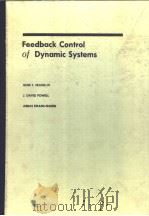《feedback control of dynamic systems fifth edition P910》
| 作者 | 编者 |
|---|---|
| 出版 | 未查询到或未知 |
| 参考页数 | |
| 出版时间 | 没有确切时间的资料 目录预览 |
| ISBN号 | 无 — 求助条款 |
| PDF编号 | 820576798(仅供预览,未存储实际文件) |
| 求助格式 | 扫描PDF(若分多册发行,每次仅能受理1册) |

1An Overview and Brief History of Feedback Control1
A Perspective on Feedback Control1
Chapter Overview1
1.1 A Simple Feedback System2
1.2 A First Analysis of Feedback5
1.3 A Brief History9
1.4 An Overview of the Book15
Summary16
End-of-Chapter Questions17
Problems18
2Dynamic Models20
A Perspective on Dynamic Models20
Chapter Overview21
2.1 Dynamics of Mechanical Systems22
2.2 Models of Electric Circuits34
2.3 Models of Electromechanical Systems39
2.4 Heat and Fluid-Flow Models44
2.5 Complex Mechanical Systems55
Summary61
End-of-Chapter Questions61
Problems62
3Dynamic Response72
A Perspective on System Response72
Chapter Overview73
3.1 Review of Laplace Transforms74
3.2 System Modeling Diagrams102
3.3 Effect of Pole Locations107
3.4 Time-Domain Specifications115
3.5 Effects of Zeros and Additional Poles121
3.6 Amplitude and Time Scaling127
3.7 Stability130
3.8 Obtaining Models from Experimental Data139
3.9 Mason's Rule and the Signal-Flow Graph141
Summary145
End-of-Chapter Questions147
Problems148
4Basic Properties of Feedback166
A Perspective on the Properties of Feedback166
Chapter Overview167
4.1 The Basic Equations of Control168
4.2 Control of Steady-State Error: System Type176
4.3 Control of Dynamic Error: PID Control186
4.4 Extensions to the Basic Feedback Concepts191
Summary210
End-of-Chapter Questions211
Problems212
5The Root-Locus Design Method230
A Perspective on the Root-Locus Design Method230
Chapter Overview231
5.1 Root Locus of a Basic Feedback System232
5.2 Guidelines for Sketching a Root Locus237
5.3 Selected Illustrative Root Loci249
5.4 Selecting the Parameter Value263
5.5 Design Using Dynamic Compensation266
5.6 A Design Example Using the Root Locus278
5.7 Extensions of the Root-Locus Method284
Summary292
End-of-Chapter Questions294
Problems295
6The Frequency-Response Design Method314
A Perspective on the Frequency-Response Design Method314
Chapter Overview315
6.1 Frequency Response316
6.2 Neutral Stability338
6.3 The Nyquist Stability Criterion340
6.4 Stability Margins353
6.5 Bode's Gain-Phase Relationship361
6.6 Closed-Loop Frequency Response365
6.7 Compensation366
6.8 Alternative Presentations of Data392
6.9 Specifications in Terms of the Sensitivity Function398
6.10 Time Delay407
Summary409
End-of-Chapter Questions412
Problems413
7State-Space Design438
A Perspective on State-Space Design438
Chapter Overview439
7.1 Advantages of State Space440
7.2 System Description in State Space441
7.3 Block Diagrams and State Space448
7.4 Analysis of the State Equations451
7.5 Control-Law Design for Full-State Feedback471
7.6 Selection of Pole Locations for Good Design485
7.7 Estimator Design497
7.8 Compensator Design: Combined Control Law and Estimator511
7.9 Introduction of the Reference Input with the Estimator524
7.10 Integral Control and Robust Tracking536
7.11 Loop Transfer Recovery (LTR)554
7.12 Direct Design with Rational Transfer Functions559
7.13 Design for Systems with Pure Time Delay563
Summary568
End-of-Chapter Questions569
Problems572
8Digital Control594
A Perspective on Digital Control594
Chapter Overview595
8.1 Digitization596
8.2 Dynamic Analysis of Discrete Systems598
8.3 Design Using Discrete Equivalents606
8.4 Hardware Characteristics615
8.5 Sample-Rate Selection619
8.6 Discrete Design622
8.7 State-Space Design Methods629
Summary637
End-of-Chapter Questions639
Problems639
9Nonlinear Systems652
Perspective on Nonlinear Systems652
Chapter Overview653
9.1 Introduction and Motivation: Why Study Nonlinear Systems?654
9.2 Analysis by Linearization656
9.3 Equivalent Gain Analysis Using the Root Locus663
9.4 Equivalent Gain Analysis Using Frequency Response: Describing Functions673
9.5 Analysis and Design Based on Stability684
Summary706
End-of-Chapter Questions706
Problems707
10 Control System Design: Principles and Case Studies716
A Perspective on Design Principles716
Chapter Overview717
10.1 An Outline of Control Systems Design718
10.2 Design of a Satellite's Attitude Control723
10.3 Lateral and Longitudinal Control of a Boeing 747742
10.4 Control of the Fuel-Air Ratio in an Automotive Engine761
10.5 Control of the Read/Write Head Assembly of a Hard Disk769
10.6 Control of Rapid Thermal Processing (RTP) Systems in Semiconductor Wafer Manufacturing777
Summary791
End-of-Chapter Questions793
Problems793
Appendix A Laplace Transforms807
A.1 The ?_ Laplace Transform807
A.2 Final Value Theorem821
Appendix B A Review of Complex Variables823
B.1Definition of a Complex Number823
B.2 Algebraic Manipulations825
B.3 Graphical Evaluation of Magnitude and Phase827
B.4 Differentiation and Integration828
B.5 Euler's Relations828
B.6 Analytic Functions829
B.7 Cauchy's Theorem829
B.8 Singularities and Residues830
B.9 Residue Theorem830
B.10 The Argument Principle831
B.11 Bilinear Transformation833
Appendix C Summary of Matrix Theory835
C.1 Matrix Definitions835
C.2Elementary Operations on Matrices835
C.3 Trace836
C.4 Transpose836
C.5 Determinant and Matrix Inverse837
C.6 Properties of the Determinant838
C.7 Inverse of Block Triangular Matrices839
C.8 Special Matrices839
C.9 Rank840
C.10 Characteristic Polynomial840
C.11 Cayley-Hamilton Theorem840
C.12 Eigenvalues and Eigenvectors840
C.13 Similarity Transformations841
C.14 Matrix Exponential842
C.15 Fundamental Subspaces843
C.16 Singular-Value Decomposition843
C.17 Positive Definite Matrices844
C.18 Matrix Identity844
Appendix D Controllability and Observability845
D.1Controllability845
D.2 Observability851
Appendix E Ackermann's Formula for Pole Placement853
Appendix F MATLAB Commands857
Appendix G Solutions to the End-of-Chapter Questions859
References875
Index885
《feedback control of dynamic systems fifth edition P910》由于是年代较久的资料都绝版了,几乎不可能购买到实物。如果大家为了学习确实需要,可向博主求助其电子版PDF文件。对合法合规的求助,我会当即受理并将下载地址发送给你。
高度相关资料
-

- DIGITAL CONTROL OF DYNAMIC SYSTEMS SECOND EDITION
- 1990 ADDISON-WESLEY PUBLISHING COMPANY
-

- Computer-Aided Design of Feedback Control Systems for Time Response
- 1978 Billing & Sons Ltd
-

- ANALYSIS OF FEEDBACK CONTROL SYSTEMS SERVOMECHANISMS AND AUTOMATIC REGULATORS
- 1955 MCGRAW-HILL BOOK COMPANY LTD.
-

- ANALYSIS AND CONTROL OF DYNAMIC ECONOMIC SYSTEMS
- 1975 JOHN WILEY & SONS
-

- BATTERIES
- 1963 PERGAMON PRESS
-

- FEEDBACK CONTROL SYSTEMS
- 1988 Prentice Hall
-

- MEMBRANE AND ULTRAFILTRATION TECHNOLOGY RECENT ADVANCES
- 1980 NOYES DATA CORPORATION
-

- BASIC FEEDBACK CONTROL SYSTEMS ALTERNATE SECOND EDITION
- 1991 PRENTICE HALL
-

- FEEDBACK CONTROL SYSTEMS THIRD EDITION
- 1996 PRENTICE HALL
-

- DYNAMIC SYSTEMS CONTROL
- 1988 JOHN WILEY & SONS
提示:百度云已更名为百度网盘(百度盘),天翼云盘、微盘下载地址……暂未提供。➥ PDF文字可复制化或转WORD




